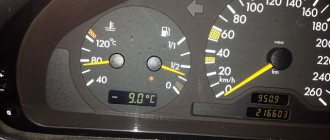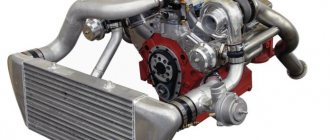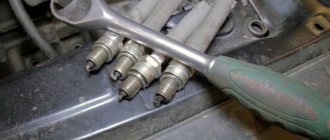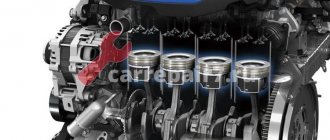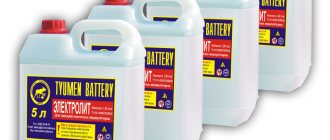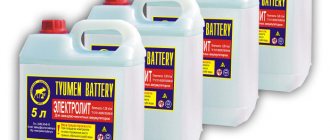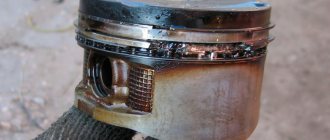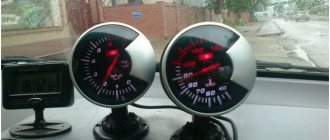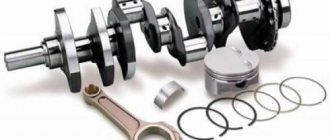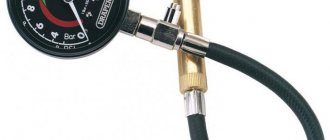Car headlights are covered on the outside with transparent caps, which once served as light deflectors. Now they provide only decorative and protective functions for complex optics located inside the headlight. It is important that they always remain transparent and do not spoil the appearance of the car, hence the sometimes need for their mechanical processing.
Why do the headlights in a car become dim?
The location of the headlights on the body is such that they absorb everything that gets into the polluted air that blows around the car at high speed.
The cap is exposed to several aggressive factors at once:
- abrasive dust raised by vehicles ahead and oncoming;
- numerous aggressive chemicals in road dirt;
- ultraviolet component of sunlight;
- internal light in the same range emitted by the headlight, it is weaker than sunlight, but is not completely limited to the visible part of the spectrum;
- high temperature of the emitting element, halogen incandescent lamps, xenon or LED sources.
In addition, the outer surface of the headlights suffers when washed; there is always a certain amount of abrasive substances in the water.
And some drivers persistently finish off the lighting fixtures, like the entire body, having the habit of simply wiping off dirt with a rag or sponge with little or no water.
Materials for making headlights and their features
As soon as they began to use material such as plastic in the manufacture of headlights, a problem immediately appeared associated with their clouding.
We often hear the words “plastic glass”, but we need to understand that this definition is incorrect, since these are two different materials. But a translucent element is a more correct definition.
Previously, glass was used in headlights (out of habit, all car enthusiasts continue to call plastic elements glass).
Glass optics were less susceptible to damage during operation.
Glass itself is a very hard material, so it resists scratching very well. But it is not able to withstand strong shock loads.
Plastic is cheaper, it is easier to create an element of complex shape from it, it has elasticity, which ensures resistance to strong impacts.
But at the same time, it has a weak hardness of the surface layers, so under external influence its surface is quickly damaged and scratches appear.
And although automakers are fighting this phenomenon by varnishing the headlight surface, practice shows that such measures are not enough.
Still, sand and small stones gradually leave a large number of scratches on the surface of the optics. But scratches aren't the only problem.
The fact is that the varnish applied to the surface of the headlights, in addition to mechanical protection, protects the plastic from exposure to ultraviolet rays, but at the same time becomes cloudy.
Hence the double problem - a fine network of scratches and cloudiness due to the sun.
Why is polishing needed?
Over time, for all the reasons listed above, the outer side of the cap becomes covered with a network of microcracks. They are not visible to the naked eye, but the picture of general turbidity is clearly visible. In addition, the chemical composition of the surface layer changes.
On the subject: What paste to polish a car at home
Transparency can only be restored mechanically, that is, by removing the damaged thin film from cracks and substances that do not transmit light well using fine grinding and polishing.
Polishing plastic headlights
A number of methods have been developed for polishing glass and plastic surfaces. The store's assortment includes a product for chemically cleaning headlights, as well as a plastic material used for polishing. A chemical cleaner is easier to use and quite effective. In relation to other materials, high recovery efficiency can be noted.
Before polishing plastic headlights, you should assess the level of damage. If there are severe deformations, you will have to use coarse sandpaper. Plastic or glass polish is made using various formulas; the best composition can be selected solely by individual consideration of the surface.
Method No. 1: Abrasive paste
Headlight abrasives containing abrasives are sold in every automotive store. Before application, be sure to read the instructions. The procedure itself is very simple and is no different from other methods of grinding head optics:
- The substance is applied to a previously cleaned coating.
- The paste is rubbed with a soft brush.
- The remaining product is removed with gentle movements.
Polishing plastic headlights using abrasive paste
When choosing the best pasta, it is recommended to pay attention to 4 options:
- Menzerna. The German brand helps remove small defects and cloudiness. Recommended for use by beginners who have no experience in polishing parts. There is no silicone in the composition. A rotary or eccentric tool is used for application. The glass is covered with a small layer of paste and waited for it to dry. When the product has hardened, it is removed with a napkin. This completes the cleaning process. The cost of 1 liter is 2100 rubles.
- ZM. It is characterized by fast action. Manufactured in the USA and meets all technical standards. Numerous user reviews indicate the successful elimination of oxidation marks, scratches and marks from the sanding machine. Suitable for processing glass and plastic. The manufacturer recommends using special polishing pads with the Trizact wheel. The price for 1 liter of liquid is 1,700 rubles.
- APP. The paste is made in Poland and does not contain silicone. Intended for treating coatings with serious damage or when it is necessary to create a matte finish. The product is evenly distributed over the surface and thoroughly polished. Cost – 1500 rubles.
- Farecla. A substance with a high-quality composition made in the UK. Promotes the appearance of an attractive shine on plastic and paintwork. The advantage is the elimination of heat when polishing with a grinder, even in the case of lengthy procedures. The paste is suitable for application by hand and with a grinding machine. If the composition gets on another surface, it can be easily removed with a napkin.
Tools and materials
For any polishing, headlights are no exception, the following consumables, devices and equipment can be used:
- polishing pastes of varying degrees of hardness and grain size;
- sandpaper by numbers, from fairly coarse (from the point of view of polishing, not wiping holes) to the finest;
- electric polishing machine;
- attachments for it, or for a drill in its absence;
- sponges for manual and mechanical work;
- masking tape for gluing adjacent areas of the body;
- a cleaning solution based on car shampoo with a good surface-active effect.
Theoretically, polishing can be done manually, but the process takes too much time. Therefore, a regular variable speed polisher or similar electric drill will be a good compromise between the manual method and a professional orbital polisher.
Why do you need headlight polishing?
A car with clean and transparent headlights looks much more attractive. Therefore, most car enthusiasts think that polishing headlights is purely a cosmetic procedure.
In fact, even small abrasions and scratches negatively affect the brightness of the light - visibility becomes worse, the headlight shines unevenly. This leads to eye fatigue and increases the likelihood of an accident. Therefore, it is not worth saving on the polishing procedure.
Headlight protection methods
If the ceramic varnish layer has already been erased from the surface, it should be restored. An alternative to this could be coating the glass with a special protective armor film, varnish of various compositions, or using factory ceramic technology. The latter is difficult to do at home.
The varnish is also not easy to apply evenly, and it does not last long. Therefore, the best solution would be to use film, which is cheap, can be applied quickly after some training and requires only preliminary washing and degreasing.
Before applying the sticker, the film must be slightly heated with a hairdryer, after which it will accurately follow the surface of the headlight of any shape.
How to polish headlights yourself
You should decide on the complexity of damage to the headlights, if everything is normal and you just need to apply a protective layer of polish that will prevent damage to the headlight glasses. To do this, it will be enough to buy the appropriate polish and rub it over the surface until a uniform protective film is formed. In the case where the headlights have not been polished for many years, a thorough deep polishing most likely cannot be avoided. The price of carrying out such a procedure in a salon is quite high, so I recommend learning how to do it yourself, this will allow you to acquire another useful skill and, accordingly, save your money.
To polish your headlights you will need the following:
- Fine-abrasive and coarse-abrasive polish (check the consumption before purchasing, bottles that are too large are a waste of money);
- Fine-grain sandpaper (1500/2000);
- Sponge;
- Painting tape, this will protect the surface around the headlights from damage;
- Grinder, grinder or drill with the ability to attach a polishing attachment.
How to clean the inside of a headlight without disassembling it
Cleaning your headlights will be much easier if you can remove the glass and take them apart piece by piece. Unfortunately, many modern car models are equipped with non-removable lenses. But even they require cleaning from time to time.
headlights need to be cleaned not only from the outside, but also from the inside
Over the years of operation, an impressive layer of dust and dirt accumulates on the optical elements. This negatively affects the quality of lighting: the headlights become dimmer and more diffuse.
Glass cleaning
Even if you don’t want to completely disassemble the headlights, you still have to remove them from the car. This process will be different for different cars: in some cases you need to remove the radiator grille, in others you need to remove the bumper. Most likely, you yourself know how to properly remove headlights from your car, but if not, take a look at the owner’s manual.
- After you remove the headlight, you need to remove all the low and high beam lamps, turn signals, and dimensions from it.
- Pour a small amount of your chosen cleaning agent into the holes.
- Now you need to temporarily seal the holes with adhesive tape and shake it properly. Usually after these manipulations, the liquid acquires a dirty yellow color. This means that you didn’t start cleaning in vain.
- Open the holes and drain the water.
- Repeat steps 2 and 3 until the water runs clear.
- If you poured soapy water into the headlight, rinse it with clean distilled water at the end.
- Use a household hairdryer to dry the inside of the headlight. Do not set the temperature too high to avoid damaging the optics. You must get rid of all the small droplets.
- Make sure the inside of the headlight is completely dry and reinsert the bulbs.
To wash away dirt from the inside of the headlight, pour the cleaning solution into the housing and shake it
There is another unusual way to clean glass from the inside. It is not suitable for serious stains, but it can help if you need to quickly remove a small stain.
You will need two small magnets, which you need to wrap in a soft cloth. Lightly moisten the fabric of one of the magnets in the cleaning agent, secure it to the fishing line and place it in the headlight housing through the hole for the lamp. Using the second magnet, control the internal one and clean the glass in the right places. When you are satisfied with the result, simply pull the line and remove the magnet from the housing.
Video: cleaning the headlight from the inside using magnets
Cleaning the reflector
The reflector inside the headlight collects the light from the lamp into a single beam. Constant exposure to a light source may cause it to become cloudy. If you notice that the light has become dimmer and more diffuse, the problem may be caused by the reflector.
To clean this part from the inside without completely disassembling the headlight, use the following method.
- Remove the car headlight.
- Remove the low and high beam lamps.
- Take a strong piece of wire about 15 cm long and wrap it halfway with electrical tape or tape.
- Place a soft, lint-free cloth over the electrical tape.
- Lightly dampen the cloth with glass cleaner.
- Bend the wire so that it can reach the reflector through the lamp hole.
- Use a cloth to gently clean the reflector. Do not make sudden movements or use force! If handled incorrectly, the protective layer on the part may peel off.
- If after finishing work there are still drops of moisture on the reflector, dry them with a regular hairdryer.
- Replace the lamps and install the headlight on the car
using such a device you can clean the reflector through the lamp hole
Basic ways to polish headlights at home
The process of returning headlights to transparency can be divided into the following stages:
- Leveling the surface to eliminate deep scratches and chips (performed using abrasive materials of various grain sizes);
- Elimination of surface damage and final polishing using special polishes, toothpaste or GOI paste;
- Surface treatment with protective varnish (reduces the porosity of the plastic, increases its resistance to mechanical damage).
If there is no deep damage, you can immediately begin treating the diffuser with a polishing compound. Let's consider the advantages and disadvantages of popular materials:
- Toothpaste. The main advantage is accessibility. Using toothpaste, you can polish the headlight by hand or using a power tool, but this treatment will not last long.
Polishing with toothpaste should only be used as a budget method for pre-sale preparation of a car. - Anti-scratch. The product gives a good effect and helps against clouding. The mixture is simply applied to the headlights and polished slowly using a soft sponge or cloth. Along with toothpaste, one of the most economical and short-lived methods.
Cheap and without additional tools - Paste GOI. Allows you to polish the polymer surface of the headlight very efficiently, as well as bring the glass lens to perfect condition. The material is affordable and is available in the form of solid bars or creamy compositions, which differ in the size of the abrasive grain. When using a solid paste, it is necessary to use a solvent (acetone, WD-40, alcohol, etc.) - it is important to choose a composition that does not damage the plastic and does not reduce the adhesion of the protective varnish that is applied after polishing.
There are now many varieties of GOI paste, ask the consultant in the store for the one you need. - Headlight polish. May be sold separately or as part of a car light treatment kit. Provides excellent and long-lasting results, especially in combination with a special activator and protective varnish. The disadvantage is the high cost.
Choose a product based on the desired result. Will it be just cosmetic straightening or a full-fledged set of measures to improve the light transmission of headlights?
Which method is more effective for polishing: video from experts
How to wash the inside of a headlight using the classic method
In its pure form, classic involves non-contact washing of the insides with a cleaning solution. The method is excellent for headlights of budget-class cars, where a minimum of electronics is used for optics. Dismantle the headlight, remove all lamps, lenses and valves of the ventilation system and that’s it - the product is ready for washing.
The cleaning solution is prepared manually. There is no universal recipe; some use glass cleaner, some use dishwashing detergent, and some even prefer household products of a more aggressive class. The safest thing to do is use a glass cleaner, not necessarily a car one.
You should purchase at the rate of one bottle of detergent per headlight. Container volume – 0.8-1 liter. Let us repeat that glass cleaner is not used in its pure form here: you should make a solution - 60% detergent, the remaining 40% tap water.
Rinse the insides with running water
This is especially important if there is sand or other abrasives in the housing. It must be washed, otherwise when rinsing with a soapy mixture, grains of sand will scratch the inner surface of the glass. Place the optics in the container
Use a plastic bowl to avoid damaging the front of the product. Pour the cleaning solution inside the headlight so that the liquid completely covers the glass when the part lies face down.
- Leave the headlights in this position for 10-15 minutes so that serious dirt has time to soak off.
- Rinse the insides with a cleaning solution. Pour the poured chemical from one corner to another (along the glass), shaking the headlight periodically.
- Drain the detergent. The most convenient way to do this is through the ventilation holes, which allow you to remove up to 98% of the contents poured inside the product.
- Rinse the insides with running water. Do not save water; not a single trace of detergent should remain.
- Rinse the headlights with distilled water. This will remove drops of tap water that leave marks after drying. The number of repetitions must be at least two.
- Dry. At the first stage, a household hair dryer is usually used to dry hair. Barely warm air is directed into the headlight through the hole for replacing lamps and flows inside for about 20 minutes, with pauses so that the product does not overheat. At the second stage, natural drying is carried out. The parts are placed in the sun, and to speed up the result, a bag of silica gel is placed inside, covering the holes with lids.
Polishing glass headlights
Today, glass headlights are extremely rare, because plastic is much more reliable, durable and cheaper. Almost all manufacturers give preference to the lightness and cheapness of plastic. Glass optics are an option for new cars or indicate the presence of an old car.
Polishing glass car headlights
The procedure for polishing plastic and glass is not much different, but there are several features:
- Before polishing, the glass should be restored using special polymer substances. Polymers are colorless, they are completely invisible and maintain the correct dispersion of the light beam. If you ignore this step, there is a high risk of destruction of the grinder wheel, personal injury and increasing the size of the crack. A UV lamp is used to dry the polymer;
- the glass surface should be regularly watered to reduce the temperature and eliminate glass particles;
- a special composition or toothpaste can be used as a polish. Car enthusiasts often prefer toothpaste due to the low cost of the composition. It is applied to the glass and rubbed with felt cloth. After treatment is completed, the remaining product is washed off. Re-processing is performed upon request.
Performing internal polishing
The best cleaning effect occurs when polishing not only the outside of the headlight, but also the inner surface, otherwise defects may appear: leaking dirt, a visible difference between the treated part and the cloudy area of the headlight.
Algorithm of actions for grinding:
- Dismantle the headlight. Initially, a thorough inspection of the coating is carried out to confirm or exclude the presence of through holes and chips. If the damage is serious and polishing will not help restore it, it is better to purchase new plastic.
- Cleaning. After removing the headlight, all dirt is removed from it.
- Degreasing the surface. You can use a household detergent, but it is better to choose a specialized degreaser.
- Grinding. The cap is immediately rinsed, then a grinding machine is connected, and then the plastic is processed with it. The nozzles should be changed every 3-5 minutes. The duration of the procedure depends on the degree of damage; it is better to focus on the result - the surface should become perfectly smooth.
- Polishing. Polish is applied to the treated and wetted coating. A rag is used for rubbing.
- Installing the headlight into the seat.
Is it possible to protect headlights from scratches?
Perhaps if you periodically perform headlight reservations. This procedure is performed by covering the surface of the headlights with polyurethane film.
- Which film to choose for headlight reservations - vinyl or polyurethane? Some amateur craftsmen prefer to use vinyl, since this film is thinner and easier to “stretch” over the headlight. But vinyl film is significantly inferior in quality to polyurethane. Vinyl becomes scratched faster, and over time begins to turn yellow and become cloudy, which significantly impairs the light transmission of headlights. Specialists at our centers recommend using anti-gravel polyurethane film for headlight armoring, and only from trusted manufacturers.
- Can film reduce light transmission? The film, indeed, can worsen the light transmission of the headlights in two cases: If you do not monitor the condition of the headlights and do not carry out the procedure for changing the film in a timely manner. Even the best films become scratched over time, so it is important to understand in time that it is time to change the film and book your headlights.
- If you use a low-quality film for booking, it will immediately become scratched and begin to become cloudy and turn yellow.
In all other cases, the polyurethane anti-gravel film does not affect the light transmission and performance of the headlights.
You can always book and polish your headlights at our Moscow Detailing centers. Select the location closest to you on the Contacts page and make an appointment at a convenient time. And if you still have questions, feel free to ask our specialists by phone and receive detailed expert answers!
Publication date:
March 16, 2018
Selection of detergent composition
The aggressive components of most products can damage the surface of the headlight and the reflector
When choosing, it is important to pay attention to the composition, as you can purchase a low-quality product without a degreaser
Distilled water does not leave streaks on the surface of transparent plastic and reflector, but is not able to wash away stagnant dust or haze from burning lamps.
How to wash internal headlight parts:
- soap composition;
- dishwashing liquid;
- shower gel.
Cosmetic micellar water to remove makeup will also help to wash the headlight from the inside.
When choosing, you should pay attention to the absence of alcohol, which can easily wash off the coating and render the optics unusable.
Disadvantages of chemical polishing
Firstly, the consequences of exposure of an unprepared car owner to the “chemistry” proposed for polishing work can be very unpleasant, especially in the absence of special protective devices and a suitably prepared room. The result may be an allergy to any active “chemicals”, including household products for treating and cleaning surfaces from dirt and scale. And if you already have an allergy, working with chemical compounds is strictly prohibited - allergy sufferers should stay away from such products.
Secondly, the waiting period for goods ordered from abroad, which can be purchased cheaper outside the Russian Federation, reaches two to three months. The reason is the sending of toxic goods dangerous to human life and health by sea, reaching the borders of Russia in 4-6 weeks, after which the products are sent to the buyer by Russian Post through the territory of the recipient’s country.
The third disadvantage is associated with the availability of dichloroethane, one of the uses of which is the basis for the creation of narcotic drugs. Most often, dichloroethane is used in the production cycle for the production of vegetable oils and varnishes; less commonly, it is used in agriculture as a disinfectant to protect grain from pathogenic fungi and insects that have a detrimental effect on the crop.
The fourth aspect is the actual composition of the liquids offered by the Chinese for chemical polishing of car headlights, which very often turn out to be ineffective and inexpensive acetone. It is easier to get the latter directly in the Russian Federation, and its price here will be lower than offers on the international Internet platform with an attention-grabbing advertising sticker.
Finally, the fifth disadvantage of chemical polishing is the purchase of a “kettle” with a heating element to raise the temperature of the liquid to the point of evaporation. Finding it is much more difficult than the “chemistry” itself, and other than using it to polish the body and headlights using a chemical method, there will be nowhere to use such a “kettle”. Buying a disposable technical product is not the best way to waste the family budget.
The main disadvantage of the “steam” method of restoring caps without the preparation provided by the technology is the inability to eliminate defects that appear on the surface and inside the material, which negatively affect the light beam formed by the lamps.
It is also necessary to remember the technological disadvantages of polishing with water vapor, or rather the complete absence of an effective result of such “processing” of a plastic or glass part - the effect of water evaporating during boiling on solid materials will simply be zero.
How to clean the inside of a headlight without disassembling it
Cleaning your headlights will be much easier if you can remove the glass and take them apart piece by piece. Unfortunately, many modern car models are equipped with non-removable lenses. But even they require cleaning from time to time.
headlights need to be cleaned not only from the outside, but also from the inside
Over the years of operation, an impressive layer of dust and dirt accumulates on the optical elements. This negatively affects the quality of lighting: the headlights become dimmer and more diffuse.
Glass cleaning
Even if you don’t want to completely disassemble the headlights, you still have to remove them from the car. This process will be different for different cars: in some cases you need to remove the radiator grille, in others you need to remove the bumper. Most likely, you yourself know how to properly remove headlights from your car, but if not, take a look at the owner’s manual.
After you remove the headlight, you need to remove all the low and high beam lamps, turn signals, and dimensions from it. Pour a small amount of your chosen cleaning agent into the holes. Now you need to temporarily seal the holes with adhesive tape and shake it properly. Usually after these manipulations, the liquid acquires a dirty yellow color. This means that you didn’t start cleaning in vain. Open the holes and drain the water. Repeat steps 2 and 3 until the water runs clear. If you poured soapy water into the headlight, rinse it with clean distilled water at the end. Use a household hairdryer to dry the inside of the headlight. Do not set the temperature too high to avoid damaging the optics. You must get rid of all the small droplets. Make sure the inside of the headlight is completely dry and reinsert the bulbs.
When working with halogen and xenon lamps, do not touch the bulb itself! Due to the high internal temperature, traces of oil from your fingers will remain on it, even if your hands are perfectly clean. This will significantly reduce its service life. Try to hold the lamps only by the base. If this is not possible, wear medical gloves.
To wash away dirt from the inside of the headlight, pour the cleaning solution into the housing and shake it
There is another unusual way to clean glass from the inside. It is not suitable for serious stains, but it can help if you need to quickly remove a small stain.
You will need two small magnets, which you need to wrap in a soft cloth. Lightly moisten the fabric of one of the magnets in the cleaning agent, secure it to the fishing line and place it in the headlight housing through the hole for the lamp. Using the second magnet, control the internal one and clean the glass in the right places. When you are satisfied with the result, simply pull the line and remove the magnet from the housing.
Cleaning the reflector
The reflector inside the headlight collects the light from the lamp into a single beam. Constant exposure to a light source may cause it to become cloudy. If you notice that the light has become dimmer and more diffuse, the problem may be caused by the reflector.
To clean this part from the inside without completely disassembling the headlight, use the following method.
Remove the car headlight. Remove the low and high beam lamps. Take a strong piece of wire about 15 cm long and wrap it halfway with electrical tape or tape. Place a soft, lint-free cloth over the electrical tape. Lightly dampen the cloth with glass cleaner. Bend the wire so that it can reach the reflector through the lamp hole. Use a cloth to gently clean the reflector. Do not make sudden movements or use force! If handled incorrectly, the protective layer on the part may peel off. If after finishing work there are still drops of moisture on the reflector, dry them with a regular hairdryer. Replace the lamps and install the headlight on the car
using such a device you can clean the reflector through the lamp hole
Never use alcohol to clean the reflector! Under its influence, the reflector will delaminate, and you will have to purchase a new optical system.
We fight yellowness and bluish bloom
Plastic headlight polishing and protection kit includes cleaning abrasive paste, protective spray and microfiber cloth
To quickly eliminate cloudy deposits and yellowness, just pop into an auto chemical store and choose a DIY headlight polishing kit. Various manufacturers have been offering something similar in retail for a long time. For example, the German brand Autosol has in its arsenal a convenient kit called “Set for polishing and protecting plastic headlights.” It includes a cleaning abrasive paste, protective spray and a microfiber cloth.
In the end, everything is done right in the parking lot. First, as mentioned above, the contact surface must be isolated with masking tape from adjacent parts. Headlights that have been cleaned of dust and dirt (an important point, since remaining debris can severely scratch the surface when wiped) should be carefully coated with restoring paste and polished by hand using a napkin.
By applying some effort for 10-15 minutes, you will be able to notice that the picture changes and the body becomes more transparent. At the end of this stage, the plastic is thoroughly washed with a stream of water or cleaned with a napkin so that no abrasive particles remain on the surface.
Ideally, the headlights should regain their original appearance, as if the car had just come out of the showroom. But to consolidate the result, a mild spray is used. This preservative is applied to the cleaned surface, after which, if necessary, it is wiped to a glossy shine with a microfiber cloth.

